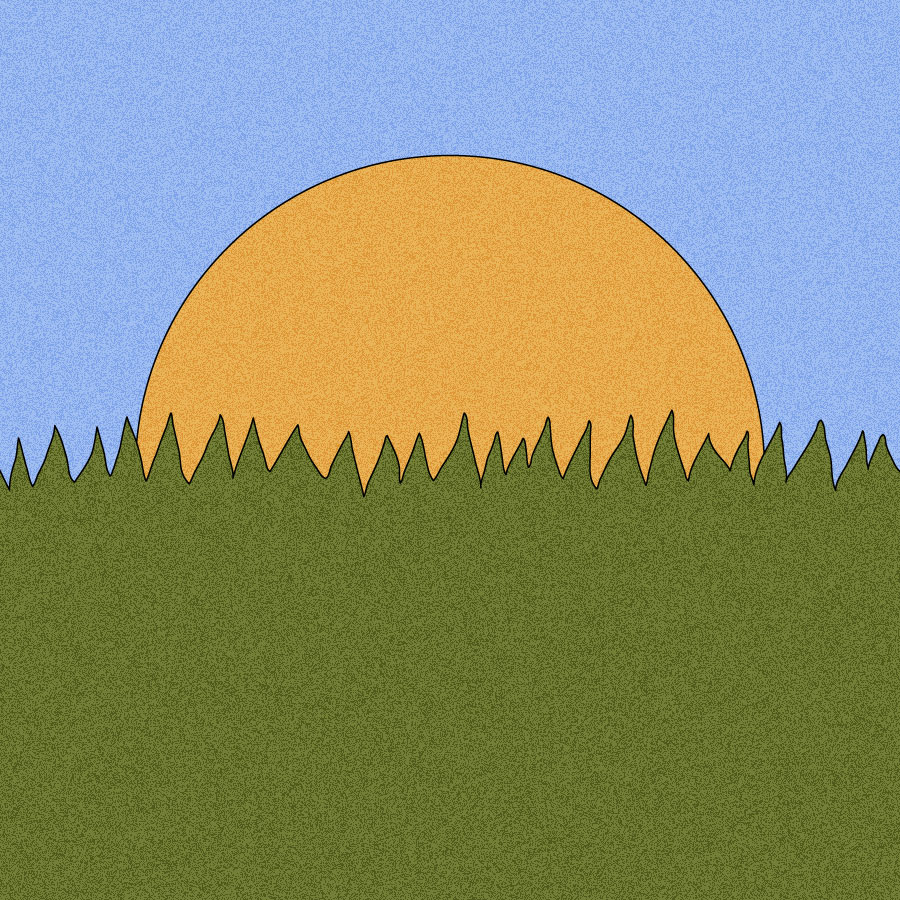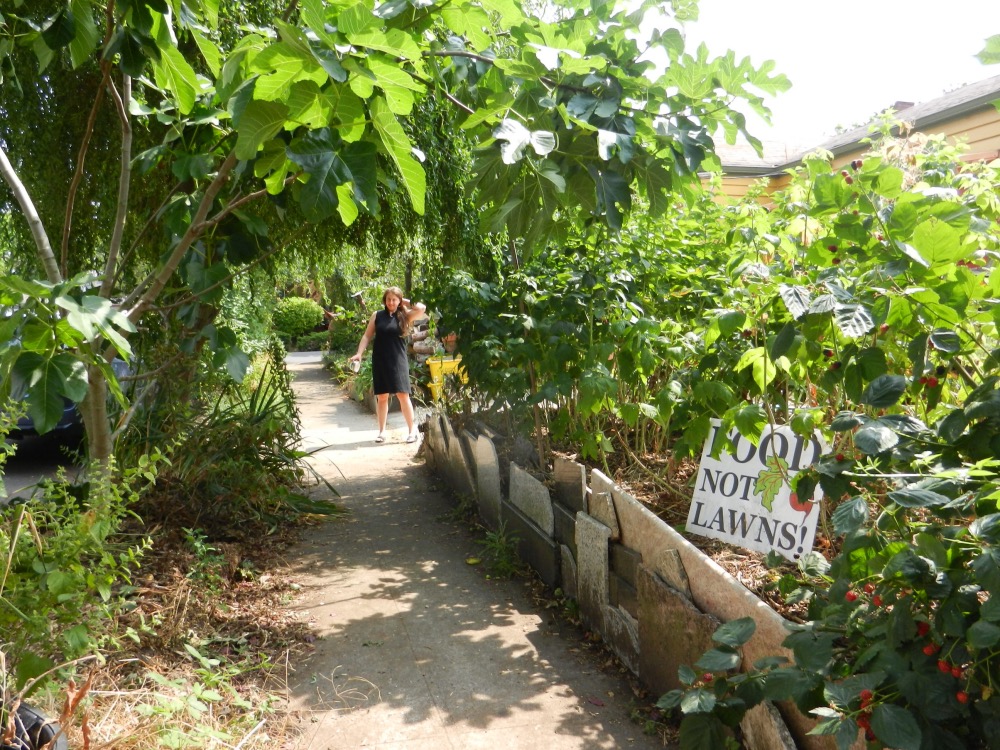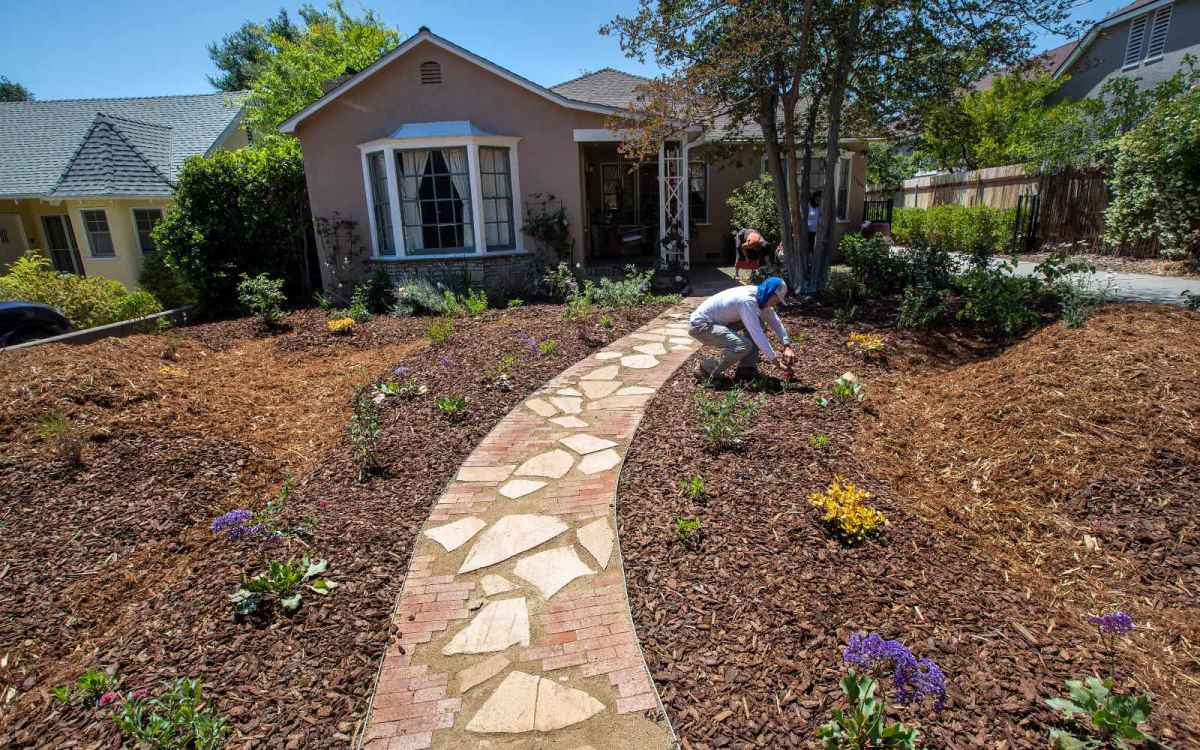

The vision
The cool blades of grass between my toes were prickly, little sticky, teeming with ladybugs.
Growing up, my dad would mow the lawn every weekend in some Sisyphean jockeying for the top spot among neighborhood men.
When people proclaimed their love for that cut-grass smell, I recoiled.
“It’s a warning to other plants and insects, didn’t you read that article?!”
Perhaps they preferred the scent of control.
It’s the 20th anniversary of the lawnmower ban. At 63, the age my father passed, I bury my head in the hill and take a deep breath — the smell of sweet, untouched relief.
— a drabble by Looking Forward reader Caitlin Caplinger
The spotlight
Americans have a great fondness for green, tidy lawns. More than 40 million acres of land in the U.S. are dedicated to turf grass — and to maintain those acres, homeowners apply around 3 million tons of nitrogen-based fertilizers per year and give their yards haircuts with gas-powered lawn care equipment, which spews an estimated 30 million tons of CO2 as well as other harmful substances, like fine particulate matter.
Caitlin Caplinger, who submitted the drabble above, recalls their father mowing the grass every single week when they were growing up. “To what aim, I do not know,” they said, knowing that the grass was only going to grow back. One day, their father came into the house crying, because he had accidentally mowed over and killed a family of bunnies. He skipped a week after that — but then he got back to it.
Caitlin was inspired to write this drabble (their first!) as part of a speculative memoir project, envisioning the world they would hope to see at 63. And we, in turn, were inspired by Caitlin’s writing to look at some of the existing solutions and alternatives moving us toward the future they envisioned, free of the climate ills of lawn care culture.
![]()
Bans on gas-powered lawn equipment are already becoming a reality. Maryland’s Montgomery County, where Caitlin lives, recently passed a ban on the sale and use of gas-powered leaf blowers, which will begin to take effect in July.
More than 200 cities and towns now have some sort of restrictions on leaf blowers — though some are noise ordinances that focus on the times that blowers can and cannot run. California is the only state so far to ban all gas-powered lawn equipment, which falls under a broad category of gas-powered, small, off-road engines.
One barrier to the green lawn care transition is the cost. While electric devices are generally on par with or cheaper than gas-powered ones, both upfront and over time, for a small or midsize business like most landscaping companies, the cost of replacing existing equipment could be crippling. That’s why many of the bans include some form of incentives or reimbursement programs. Montgomery County’s, for instance, includes $100 rebates for residents and businesses who switch to electric leaf blowers.
![]()
Another growing movement is eschewing manicured lawns altogether. You may have seen the slogan “leave the leaves” on your Instagram or TikTok recently. One user on X joked earlier this month: “Hey, man. The leaves. They fell off your tree. They’re incredibly biodegradable, and will be gone by the end of winter. So you better hurry up and rake them into plastic bags.”
The pressure to take up the rake, or the loud, polluting blower, ties back to our obsession with neat and tidy lawns. But there are other models for landscaping that work with, rather than against, local ecosystems. Pollinator gardens, for example, focus on native flowers and other plants that provide food and shelter to pollinating critters. In wet climates like the Pacific Northwest, rain gardens help to capture and filter stormwater; in drought-stricken or desert climates, dryscaping could be favorable — an approach that focuses on water conservation with mulching and succulents.
Another model would repurpose lawn space to grow something more useful: food. “It’s so obvious, but nobody in the U.S. really does it,” said Heather Jo Flores, a writer and permaculture teacher. In the late ’90s, Flores helped start a movement called Food Not Lawns (in no way affiliated with the weirdly problematic Facebook page “Grow Food, Not Lawns”).

A photo Flores took of a friend’s front-yard garden in Portland, Oregon, in 2015. Heather Jo Flores
Flores has seen interest in growing food blossom over the past two decades, with a particular spike during the pandemic. A free permaculture program that Flores and others compiled online saw 50,000 sign-ups during the first month of lockdowns in 2020. “As soon as people had time off, that was what they wanted to do,” Flores remarked. “They wanted to be in the garden. And I thought that was lovely.”
The pandemic temporarily removed one barrier to starting a home garden: time. Another, more difficult one, is access to land. As Flores pointed out, skyrocketing housing costs all over the country have made it so that many of the people who would like to be spending time with their hands in the dirt don’t have a plot of dirt to call their own.
Even for those who do have a bit of green space, the path away from manicured grass can face roadblocks. Grist’s climate solutions writer Gabriela Aoun Angueira has wanted to convert her yard in Southern California to more drought-tolerant landscaping ever since she moved in about four years ago. “It has always felt extremely wasteful to use water for these lawns,” she said. Last summer, she did let her backyard go brown. But she doesn’t want the front yard to become an eyesore — both for her neighbors’ sake, and because it could land her in trouble with her HOA. Her vision is to replace the lawn with native vegetation that would require much less water than turf grass. But the cost has proved intimidating — as well as the knowledge required to map out a design that would prevent erosion on her sloped yard, and the need to submit a plan for approval from the HOA.
For now, she’s approaching the project in phases: She replaced two strips of her backyard with drought-tolerant plants, for a total of about $300, and installed a sprinkler-control system that she can monitor and adjust from an app on her phone. “That was an interim solution that I think really made a difference in my water use, while I’m still traveling along this journey,” she said.
![]()
For Caitlin Caplinger, control has also been a limiting factor. They now live in a condo where the landscape is maintained by an industrial lawn care service. Sometimes it’s so loud that even their noise-canceling headphones won’t drown out the din. They joined their condo board so they could start a sustainability committee, although so far, the idea of saying goodbye to lawnmowers hasn’t been popular.
Caitlin added that another crisis was also on their mind when they wrote the drabble above: the bombardment of Gaza. The Israeli military’s relentless tactics have been referred to as “mowing the grass.” In the drabble, they noted that the colors of the ladybugs and grass evoke the Palestinian flag, and the scene shows a future where all life is valued and protected. The lawnmower ban is both a literal lawnmower ban, and a metaphor for peace — both of which they hope to see in their lifetime. They said, “I want that to be a thing that we celebrate for years to come.”
— Claire Elise Thompson
P.S. Got a drabble of your own to send in? We would love to read it! And we’d like to feature more of them in the newsletter like this. Email us anytime at lookingforward@email.grist.org to share your 100-word vision for our climate future.
More exposure
A parting shot
A resident in Pasadena, California, converted his grass lawn to mulch and drought-tolerant plants last summer, when the Metropolitan Water District of Southern California issued strict limitations on outdoor watering.






